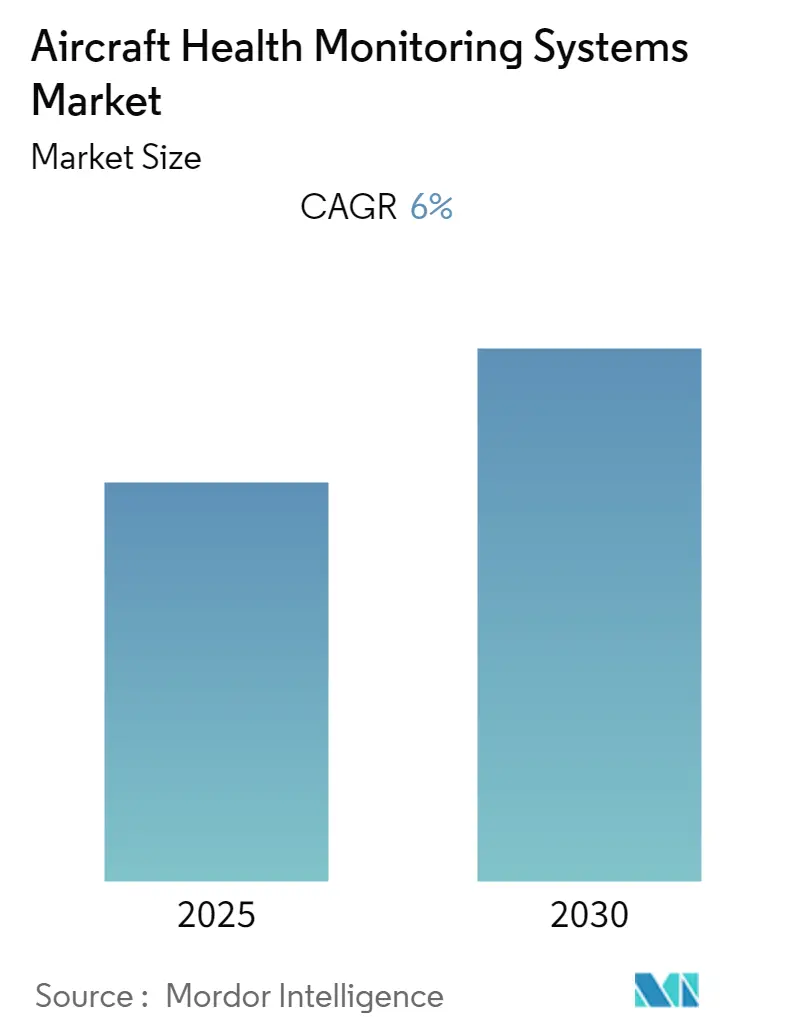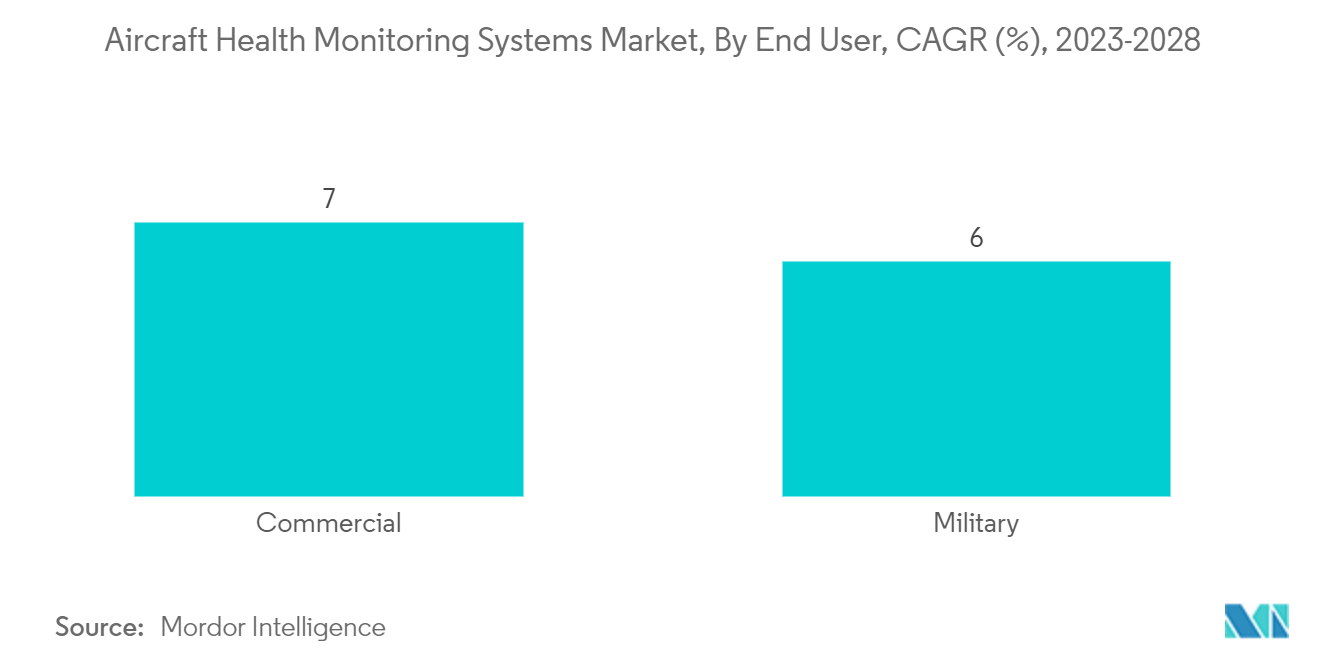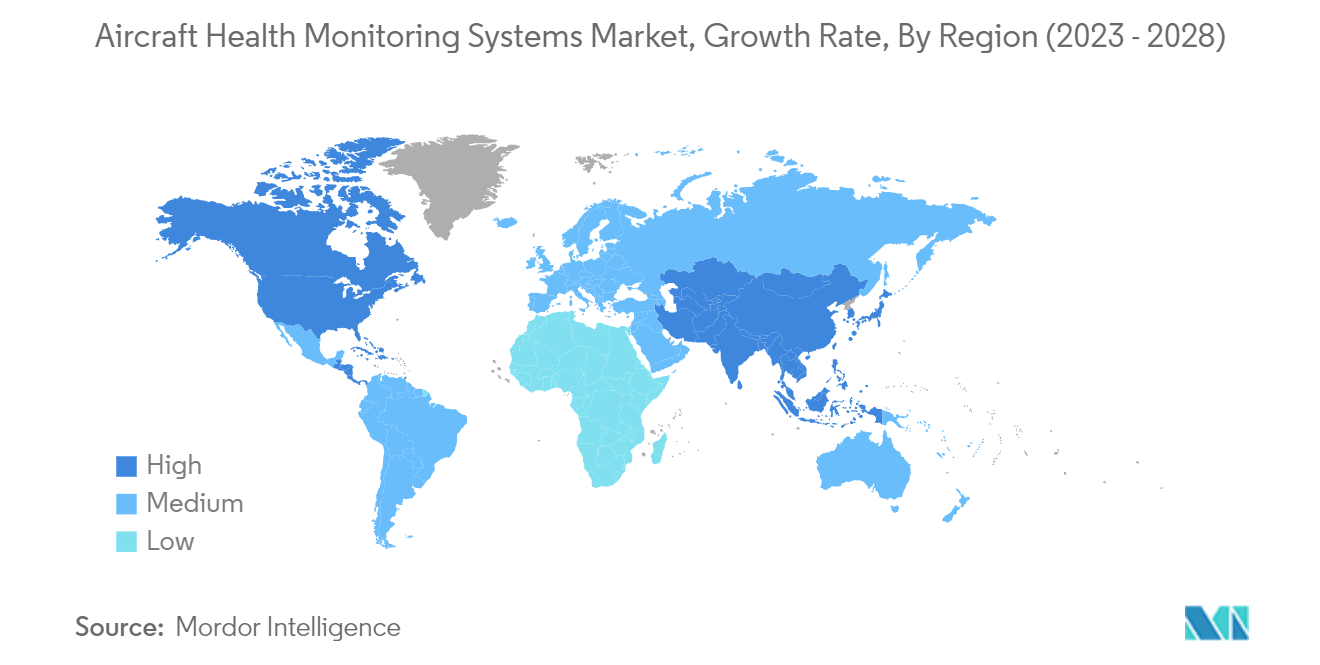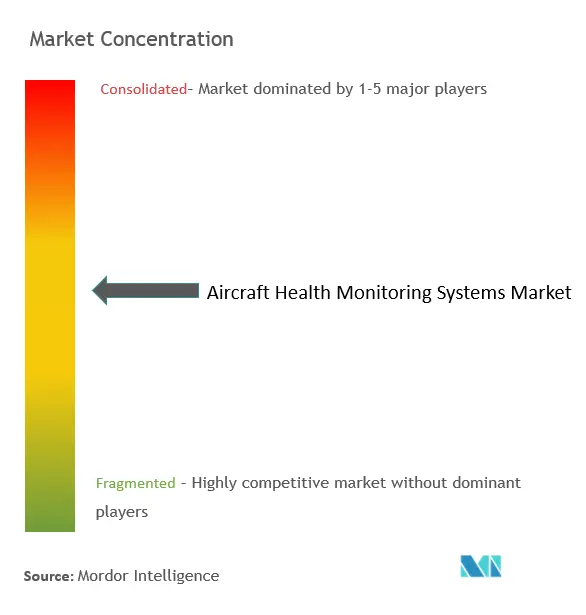Aircraft Health Monitoring System Market Analysis
The Aircraft Health Monitoring Systems Market is expected to register a CAGR of 6% during the forecast period.
The COVID-19 pandemic had a major effect on the Aircraft Health Monitoring Systems Market. The onset of the COVID pandemic led to various governments across the globe implementing stringent lockdowns and banning import-export activities. This led to a sudden fall in the demand for air travel thereby leading to various aircraft being grounded across the globe. In addition, nationwide lockdowns also led manufacturers of airline health manufacturing to partially or completely shut down their operations. Moreover, adverse impacts of the COVID-19 pandemic have resulted in delays in activities and initiatives regarding the development of advanced aircraft health monitoring systems worldwide. On the other hand, the decline in the COVID-19 pandemic led to the opening up of border restrictions thereby leading to the free flow of goods and also leading to an increase in the number of passenger traffic in various countries. The lifting of the lockdown also led to a growth in the manufacturing of advanced aircraft health monitoring systems by the manufacturers and this will lead to development and growth in the market during the forecast period.
The increased need to improve the safety, performance and operational efficiency of aircraft and the rise in demand for real-time aircraft data monitoring systems are the growth levers for the market. An increase in the adoption of connected aircraft solutions is another major factor helping the growth of the aircraft health monitoring systems market. Another factor affecting the adoption of advanced aircraft health monitoring systems is the need to reduce MRO costs. Continuous monitoring of aircraft systems prevents immediate requirements or replacements of parts and components. Such factors are likely to supplemnt the growth curve of market over the forecast period.
Aircraft Health Monitoring System Market Trends
By End User, The Commercial Segment is Expected to Witness Significant Growth During the Forecast Period
By end user, the commercial segment is expected to witness significant growth during the forecast period. The increasing number of aircraft deliveries owing to the increasing air passenger traffic is one of the main reasons for the growth of the market during the forecast period. With the growing aircraft fleet and destinations of the airlines, airlines are now proportionally making investments in a real-time health monitoring system that will help them reduce maintenance repair and overhaul costs, by reducing the time required for inspecting the airline to determine the airworthiness of the aircraft.
Approximately 30% of the total delay times that the aviation industry currently faces are due to the incurrence of unplanned maintenance. To avoid these delays, the airlines, in partnership with MRO providers, are replacing the traditional inspection procedures, such as general and detailed visual inspections, as well as non-destructive inspections, such as x-rays. Continuous monitoring of parts may result in eliminating time-consuming steps, like the dismantling process to gain access to the inspection areas. For instance, the Skywise Health Monitoring device which has been developed by Airbus provides constant support by ensuring that airline companies are able to carry out health monitoring of the airlines efficiently. Moreover, the constant R&D in the development of new health monitoring systems with advanced technology and sensors is anticipated to support the growth of the segment during the forecast period.
The Asia-Pacific Segment is Expected to Witness Significant Growth During the Forecast Period
The region of Asia-Pacific is expected to witness significant growth during the forecast period. The Asia-Pacific region witnessed an increase in the number of aircraft owing to the growth in air passenger traffic and this will be the main reason for the growth of the market during the forecast period. Moreover, the presence of various manufacturers in the region who are engaged in developing advanced aircraft health monitoring systems is the other factor for the growth of the market. In the present times, China and India are the two major nations that have witnessed an increase in terms of air passenger traffic as well as aircraft deliveries. As of October 2022, Air India announced that they are in plan to procure five large-body Boeing aircraft and 25 narrow-body Airbus aircraft in order to cater to the growing air passenger traffic and expand its fleet. In addition, the growing number of maintenance, repair and overhaul facilities in the Asia-Pacific region will lead to a reduction in the inspection time of the aircraft thus enabling the aviation industry to function smoothly. Thus, such developments will propel the growth of the market during the forecast period.
Aircraft Health Monitoring System Industry Overview
Airbus SE, The Boeing Company, Collins Aerospace (United Technologies Corporation), Honeywell International Inc. and GE Aviation amongst others are some of the major players in the market. Although the health management systems are produced by the engine manufacturers and the MRO providers, aircraft OEMs, like Airbus and Boeing, are offering their health monitoring solutions to drive the aftermarket revenues. Players may make use of emerging technologies, like smart sensors, in designing new types of aircraft health monitoring systems, and thereby increase their market share by attracting new customers. Product innovation and investment in R&D may play a vital role in the success of the new and existing players in this market in the coming years. For product innovations, various stakeholders (MRO providers, aircraft OEMs, technology providers, and airlines) in the market are collaborating to develop and manufacture new AHM and predictive maintenance solutions.
Aircraft Health Monitoring System Market Leaders
-
Airbus SE
-
The Boeing Company
-
Collins Aerospace (United Technologies Corporation)
-
Honeywell International Inc.
-
GE Aviation
- *Disclaimer: Major Players sorted in no particular order
Aircraft Health Monitoring System Market News
In April 2022, Lufthansa Technik announced that they have recently enhanced its AVIATAR digital platform with various new digital fleet management applications for the Boeing 737 NG (Next Generation), which are now made available to 737 operators around the world.
In March 2022, Indigo announced that they have become the 55th airline to adopt the Skywise Health Monitoring (SHM) as its future fleet performance tool. The product which was launched in 2019, SHM gathers live diagnostic feeds from the aircraft through its ACARS (aircraft communications, addressing, and reporting system) link to the airline's information system.
Aircraft Health Monitoring System Industry Segmentation
Aircraft Health Monitoring System (AHMS) is a collection of strategies, tools, solutions, and approaches that are closely connected to a hardware and software system that performs remote monitoring of airplane data in order to understand its present or future serviceability and performance.
The Aircraft Health Monitoring Systems Market is segmented by end-user, subsystems, integrated vehicle health management systems, and geography. By end user, the market has been segmented by commercial and military. By subsystems, the market has been segmented by aero-propulsion, avionics, ancillary systems, and aircraft structures. By integrated vehicle health management systems, the market has been segmented into diagnostics, prognostics, condition-based maintenance, and adaptive control. By geography, the market has been segmented by North America, Europe, Asia-Pacific, Latin America, and the Middle East and Africa. Moreover, the report offers a market forecast and is represented by USD million. Furthermore, the report also includes various key statistics on the market status of leading market players and provides key trends and opportunities in the Middle East and Africa Inflight Entertainment and Connectivity Market.
| End User | Commercial | ||
| Military | |||
| Subsystem | Aero-propulsion | ||
| Avionics | |||
| Ancillary Systems | |||
| Aircraft Structures | |||
| Integrated Vehicle Health Management (IVHM) Systems | Diagnostics | ||
| Prognostics | |||
| Condition-based Maintenance and Adaptive Control | |||
| Geography | North America | United States | |
| Canada | |||
| Europe | Germany | ||
| United Kingdom | |||
| France | |||
| Rest of Europe | |||
| Asia-Pacific | China | ||
| India | |||
| Japan | |||
| Australia | |||
| South Korea | |||
| Rest of Asia-Pacific | |||
| Latin America | Mexico | ||
| Brazil | |||
| Rest of Latin America | |||
| Middle East and Africa | United Arab Emirates | ||
| Saudi Arabia | |||
| South Africa | |||
| Rest of Middle East and Africa | |||
Aircraft Health Monitoring System Market Research FAQs
What is the current Aircraft Health Monitoring Systems Market size?
The Aircraft Health Monitoring Systems Market is projected to register a CAGR of 6% during the forecast period (2025-2030)
Who are the key players in Aircraft Health Monitoring Systems Market?
Airbus SE, The Boeing Company, Collins Aerospace (United Technologies Corporation), Honeywell International Inc. and GE Aviation are the major companies operating in the Aircraft Health Monitoring Systems Market.
Which is the fastest growing region in Aircraft Health Monitoring Systems Market?
Asia Pacific is estimated to grow at the highest CAGR over the forecast period (2025-2030).
Which region has the biggest share in Aircraft Health Monitoring Systems Market?
In 2025, the Asia Pacific accounts for the largest market share in Aircraft Health Monitoring Systems Market.
What years does this Aircraft Health Monitoring Systems Market cover?
The report covers the Aircraft Health Monitoring Systems Market historical market size for years: 2020, 2021, 2022, 2023 and 2024. The report also forecasts the Aircraft Health Monitoring Systems Market size for years: 2025, 2026, 2027, 2028, 2029 and 2030.
Our Best Selling Reports
Aircraft Health Monitoring System Industry Report
Statistics for the 2025 Aircraft Health Monitoring Systems market share, size and revenue growth rate, created by Mordor Intelligence™ Industry Reports. Aircraft Health Monitoring Systems analysis includes a market forecast outlook for 2025 to 2030 and historical overview. Get a sample of this industry analysis as a free report PDF download.







